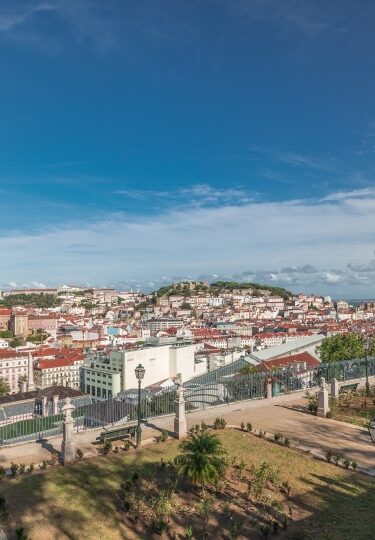Príncipe Real, Lisbon’s trendy and elegant central hilltop neighborhood, is a delight to amble and explore, particularly for its pretty sidestreets, first-class restaurants, and quality boutiques.
Across the district, leafy squares shaded by aging trees shelter coffee kiosks, terraces, and impressive viewpoints. Mansions and palaces sit side-by-side with sprawling botanical gardens and low-key, family-run tascas. And independent galleries, vintage and concept stores, and artisanal produce traders provide plenty of retail therapy. It’s a beguiling blend of contemporary bohemian vibes against a grand backdrop of 18th- and 19th-century architecture constructed for the district’s affluent and aristocratic residents.
An afternoon wandering in Príncipe Real, one of Portugal’s prettiest pocket-sized neighborhoods —ideally ending with watching the sunset from its fabled miradouro, or viewpoint—is one of Lisbon’s best experiences.
Attractions in Príncipe Real
Miradouro de São Pedro de Alcântara
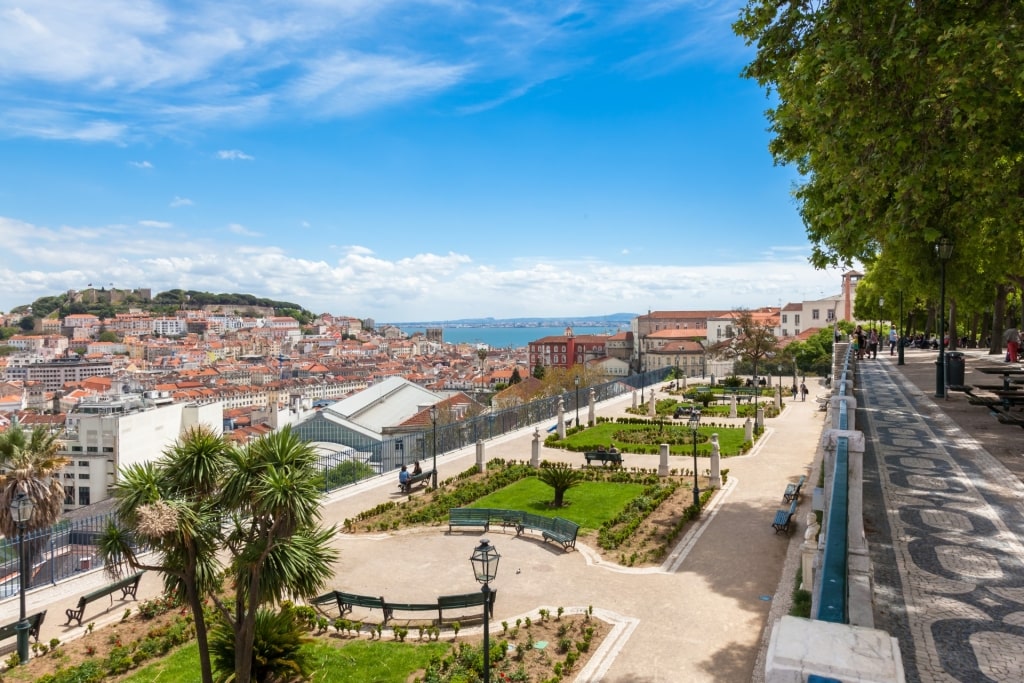
Miradouro de São Pedro de Alcântara
Providing the most picturesque greeting to Príncipe Real, Lisbon, that one could wish for, Miradouro de São Pedro de Alcântara is a welcome sight—and not only for being a flat pause after climbing the sometimes steep streets to arrive.
The well-manicured, two-tiered terrace is one of Lisbon’s finest miradouros, providing photogenic views across many of the city’s finest features. Downtown Baixa’s russet rooftops, with their grid-like organization, angle towards the glittering Tagus River. Jumbles of colorful buildings cling to the hills opposite and the walls of 10th-century Castelo de São Jorge stare back in all their glory.
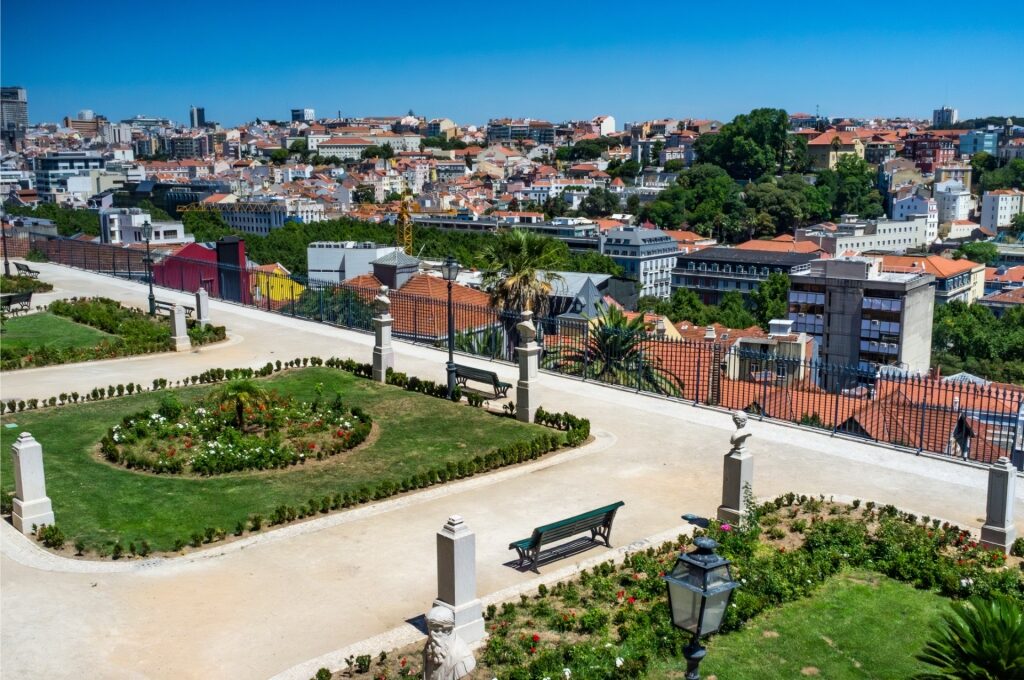
Miradouro de São Pedro de Alcântara
While overworking your camera, walk between the upper and lower levels’ flower beds, fountains, and sculptures depicting important Portuguese figures before settling in for a port, chilled glass of wine, or snack at Quiosque Miradouro, one of Lisbon’s remaining traditional octagonal garden kiosk bars. Snag one of the deckchairs for a more comfortable and less obstructed view.
Better still, return for a sunset drink when Lisbon’s famous golden light gifts the city an ethereal halo. Often, buskers and a growing crowd of beer-sipping locals—it’s allowed to bring your own drinks—add to the magic of watching the city transform from a daytime postcard to a clutch of twinkling lights.
Read: Best Things to Do in Lisbon
Jardim Botânico de Lisboa
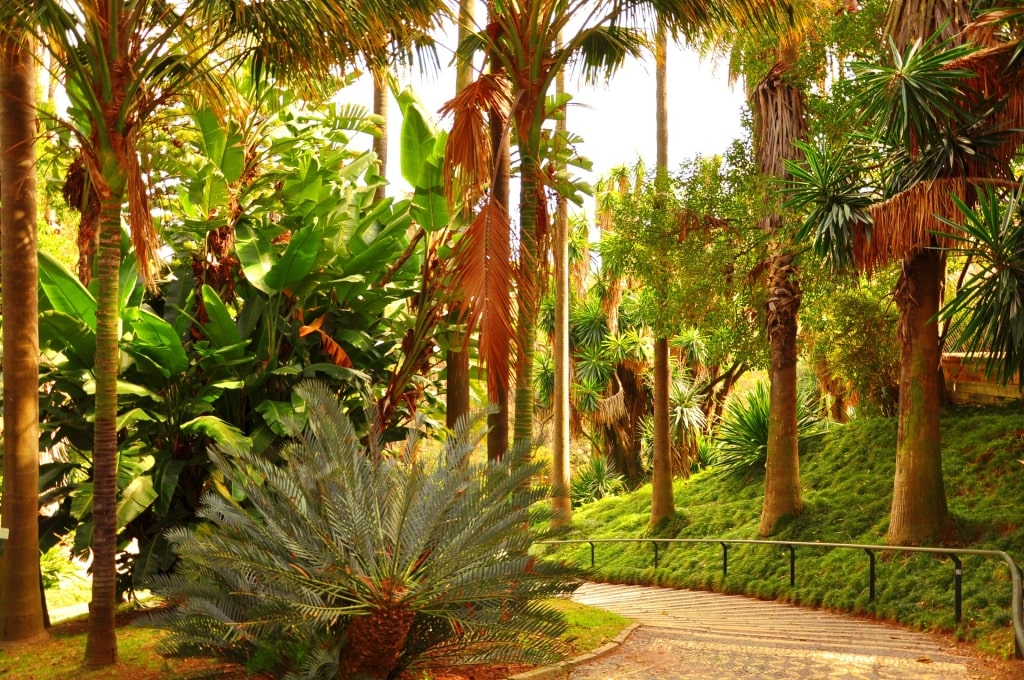
Jardim Botânico de Lisboa
Practically hidden from sight, the Jardim Botânico de Lisboa—one of three botanical gardens in the city cared for by the University of Lisbon—is Príncipe Real’s unexpected green lung.
Part of and adjacent to the neoclassical National Museum of Natural History and Science, the gardens and museum can be visited independently or on a combined ticket.
Founded in the late 19th century, the nearly 10,000-acre sloping space is networked by dusty walking trails that weave through diverse plant species from across the globe. Flora from Portugal’s former colonies and countries “discovered” during the empire-expanding Age of Discovery are particularly well represented.
You won’t need more than an hour here unless you’re a botanist. But on a sunny day, ambling under the canopy of soaring palms, between bamboo and lily ponds, and studying tropical figs to African bird-of-paradise flowers is a welcome, shaded respite.
Reservatório da Patriarcal
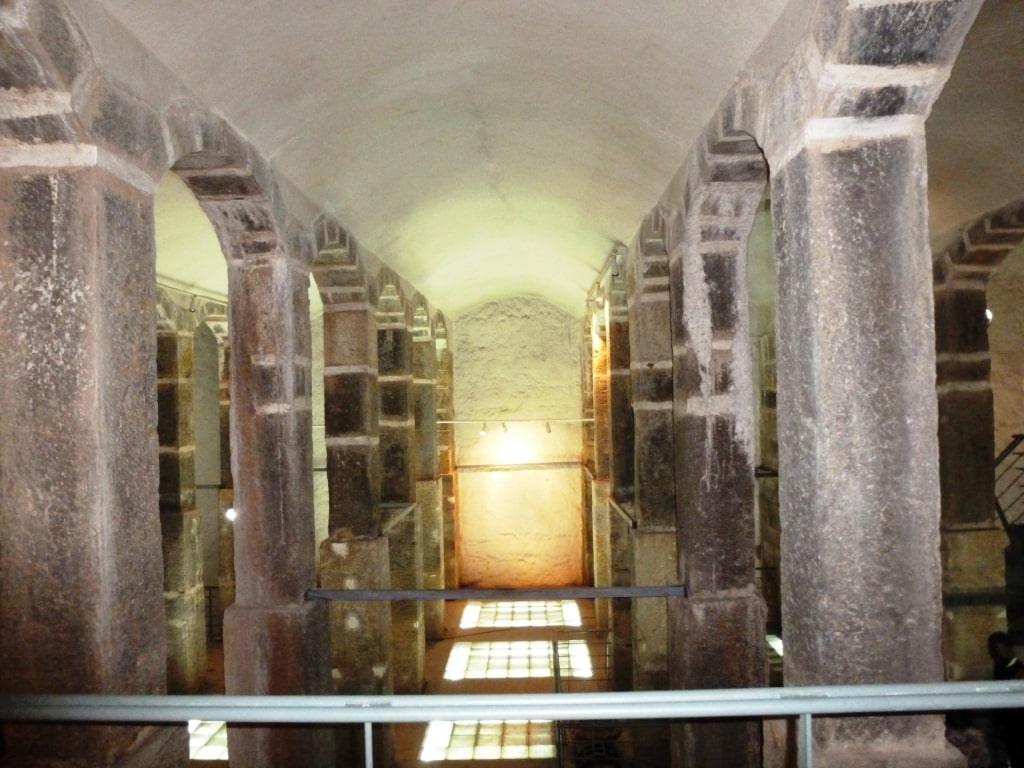
Reservatório da Patriarcal Photo by Nicola on Wikimedia Commons, licensed under CC BY-SA 3.0
Even more hidden from view, the Reservatório da Patriarcal water reservoir is concealed underneath the Jardim do Príncipe Real. The only clue of its position is the garden’s octagonal fountain, which shares the same shape as the reservoir below.
Opened in 1864 to improve Lisbon’s water supply, the reservoir was decommissioned in the mid-20th century. Now, it’s part of the city’s Museu da Água, which offers underground guided visits a few days a week, guiding visitors through the cistern and underground galleries.
Yet the best way to appreciate the subterranean space is to attend one of the candlelit fado musical concerts hosted by the Real Fado company twice weekly. Tickets are popular, so pre-booking is essential. Hearing the haunting echo of Portugal’s most famed musical genre being belted in the acoustically pleasing venue makes the visit far more memorable.
If the Reservatório da Patriarcal’s restrictive opening hours don’t align with your visit, there’s a second reservoir on the edge of Príncipe Real, the Reservatório da Mãe d’Água das Amoreiras, which is open more regularly.
Palácio da Assembleia da República
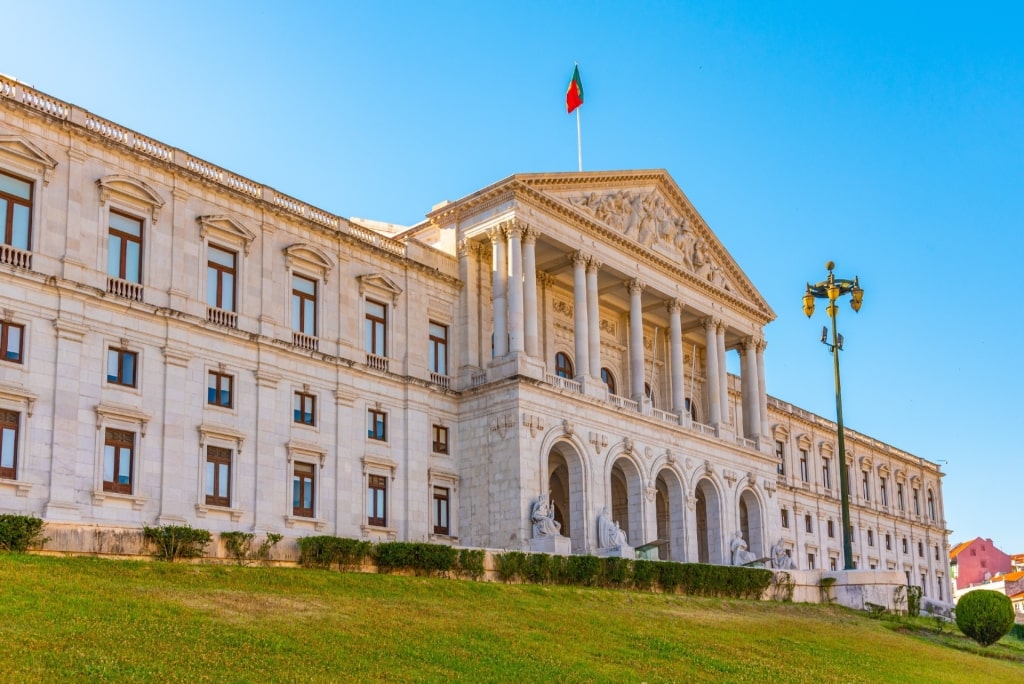
Palácio da Assembleia da República
Located on the western side of Príncipe Real, where the neighborhood merges into the political São Bento district, the Palácio da Assembleia da República—home to Portugal’s parliaments in one form or another since 1834—is one of Lisbon’s most significant landmarks.
Constructed at the tail end of the 16th century, the imposing São Bento Palace initially served as a monastery before Portugal’s Liberal Revolution. In the late 1800s, it was overhauled following extensive fire damage, resulting in its modern neoclassical facade.
The palace is still used by Portugal’s government today and it’s only possible to see the interior on a pre-booked guided visit. Tours take in the monumental, cross-like staircase, staterooms, and, depending on governmental business, the session and senate rooms.
Just behind the main building is the Palacete de São Bento, home to Portugal’s current serving prime minister. While the residential space is closed to the public, the premier’s pretty private gardens, the Jardim do Palácio de São Bento, can be visited on Sundays.
Things to Do in Príncipe Real
Ride the Vintage Elevador da Glória Funicular
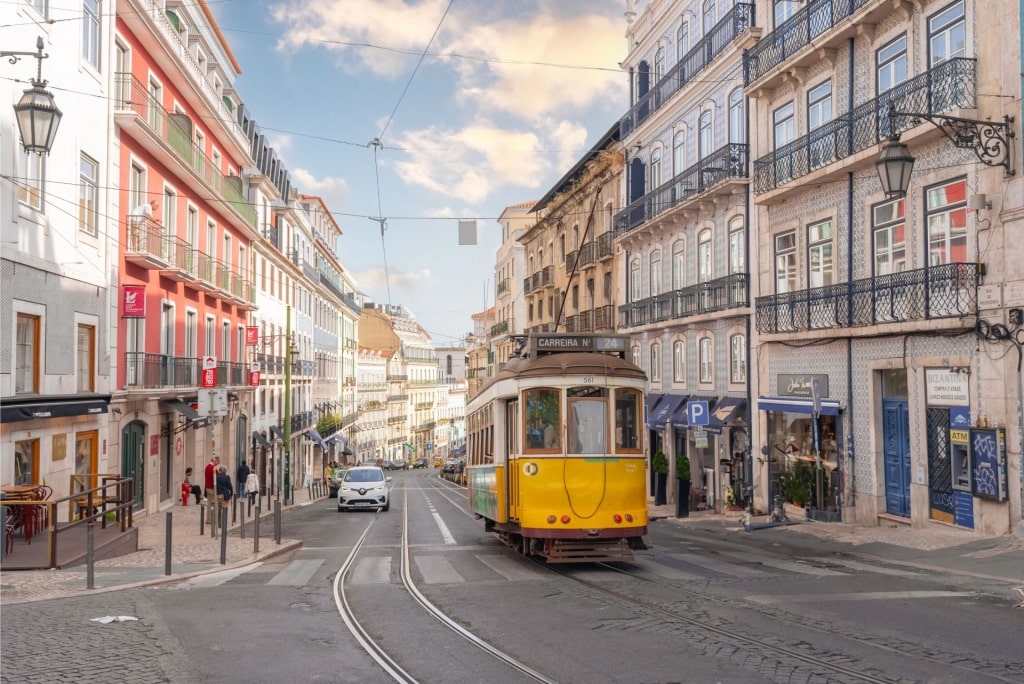
Elevador da Glória Funicular
In Príncipe Real, Lisbon’s vintage yellow trams skirt around the edges, making the equally photogenic Glória Funicular the best way to reach the neighborhood without breaking a sweat.
Opened in 1885, the elevador is Lisbon’s second-oldest and was constructed so residents could avoid the steep incline when returning from the downtown shopping district.
Still part of the city’s public transport network today, the yellow single carriage affords a quick, if brief, vintage ride from Praça dos Restauradores, near shopping-heavy Avenida da Liberdade, to Miradouro de São Pedro de Alcântara.
Walking alongside the funicular is possible, which provides some classic Lisbon photos. If you don’t mind the climb and simply want the experience of riding a vintage funicular, take the return trip instead—it’s often less crowded and usually has a shorter wait time.
Relax With a Coffee in Jardim do Príncipe Real
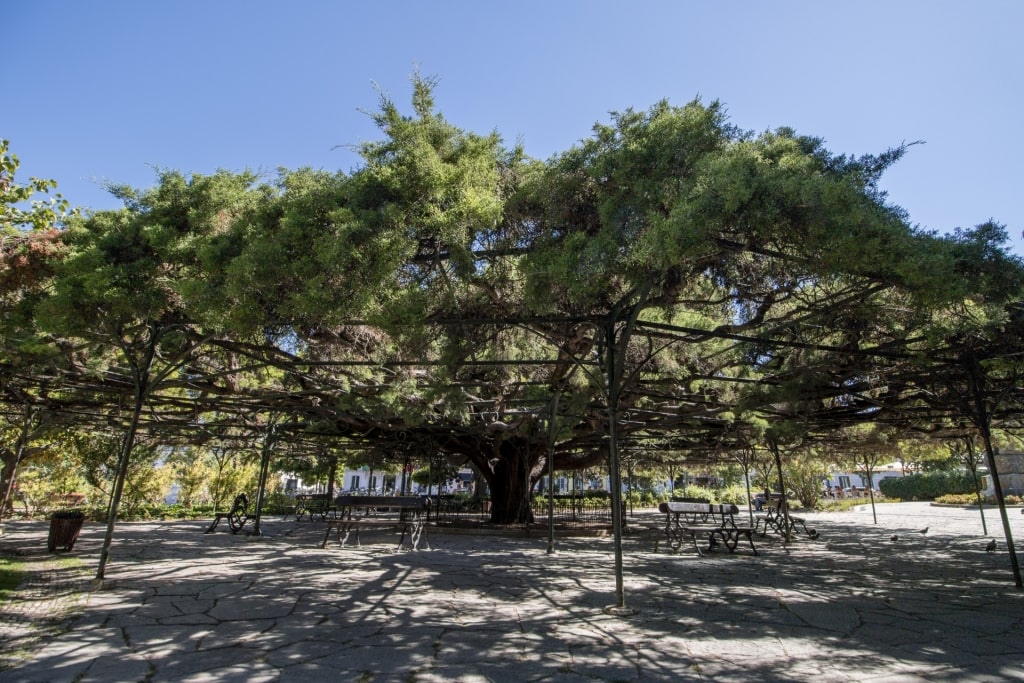
Jardim do Príncipe Real
Snuggled in the heart of the neighborhood, leafy Jardim do Príncipe Real is the perfect place to soak up the district’s atmosphere as locals rest under the shade of the juniper tree arbor or sip a bica, or espresso, at Quiosque Príncipe Real.
This is another of Lisbon’s iconic free-standing kiosks, albeit a modern reincarnation of those that became prevalent in the mid-19th century, and pausing for a coffee, beer or wine here is practically a Príncipe Rea rite of passage.
Shop Local Artisanal Products & Vintage Finds
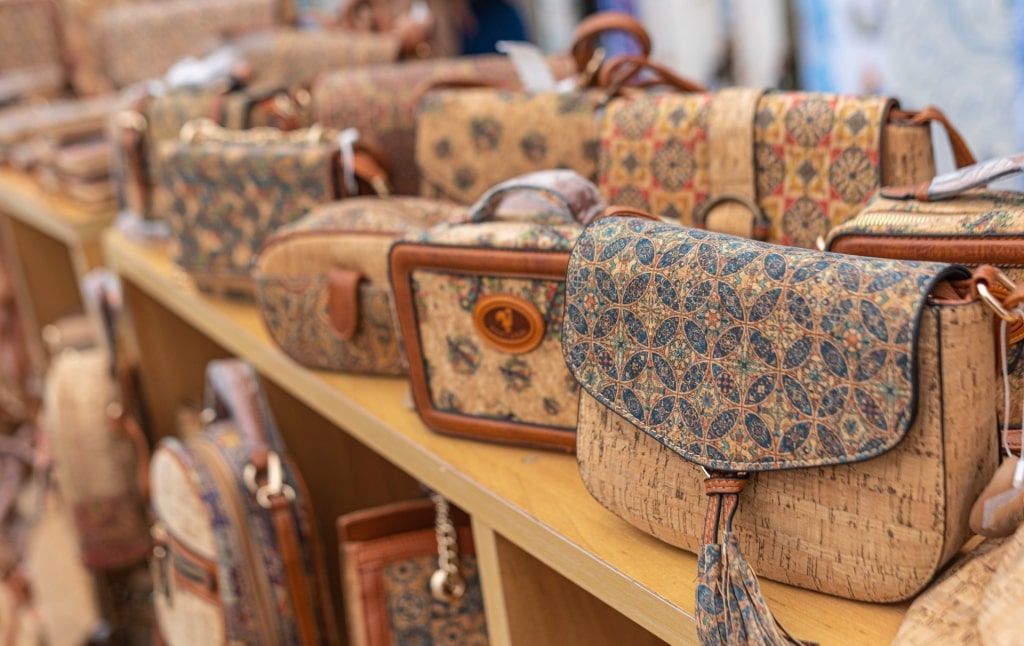
Portuguese souvenirs
Home to an ever-growing collection of designer boutiques, concept stores, antique traders, and artisanal producers, Príncipe Real, Lisbon is a real treat for shoppers. Unlike nearby Baixa and Avenida da Liberdade, where chain stores are fast taking over, this neighborhood is a treasure trove of independent retailers.
One of the best places to shop in Lisbon is the EmbaiXada shopping mall. Formerly the Ribeiro da Cunha Palace, the late 19th-century building was constructed in a neo-Moorish style.
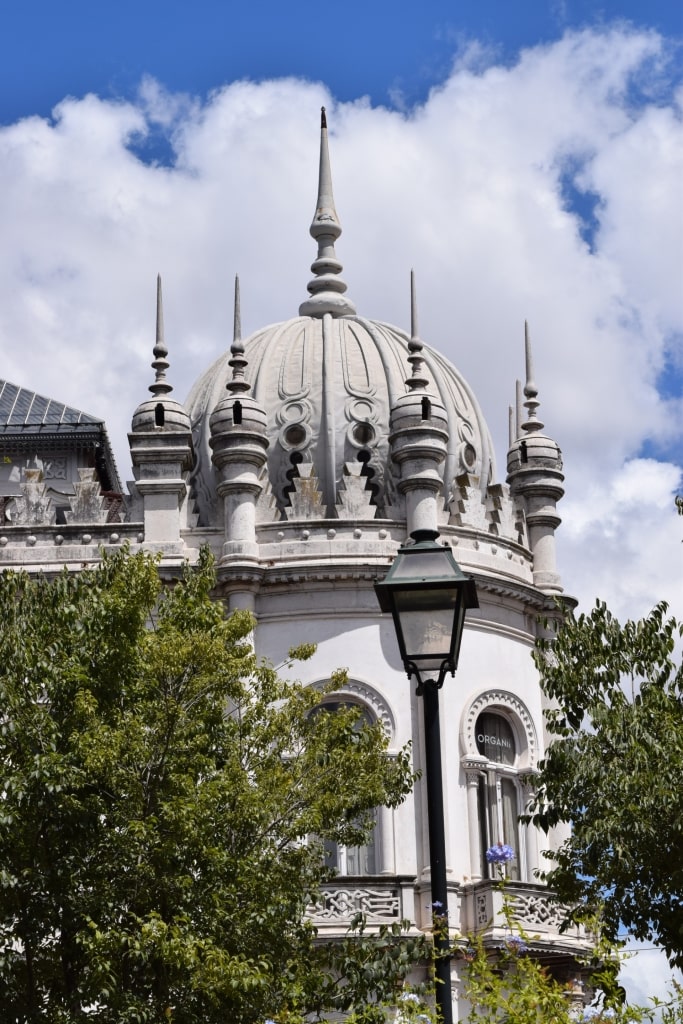
EmbaiXada shopping mall
Restored architectural features, including Arabic arches, a multi-level interior courtyard, and a carpet of ceramic tiles, add a splash of grandeur to shopping the resident Portuguese brands, such as Castelbel’s luxury soaps and Fernanda Velez’s fashion.
Other notable stores across Príncipe Real include Mateo for unique jewelry pieces, aq2 for vintage clothing, and Aristopassagem for antique art pieces. The district hosts a food market every Saturday, while the last Saturday or Monday of the month sees the popular Príncipe Real flea market hawk antiques and handicrafts.
Visit Príncipe Real’s Religious Treasures
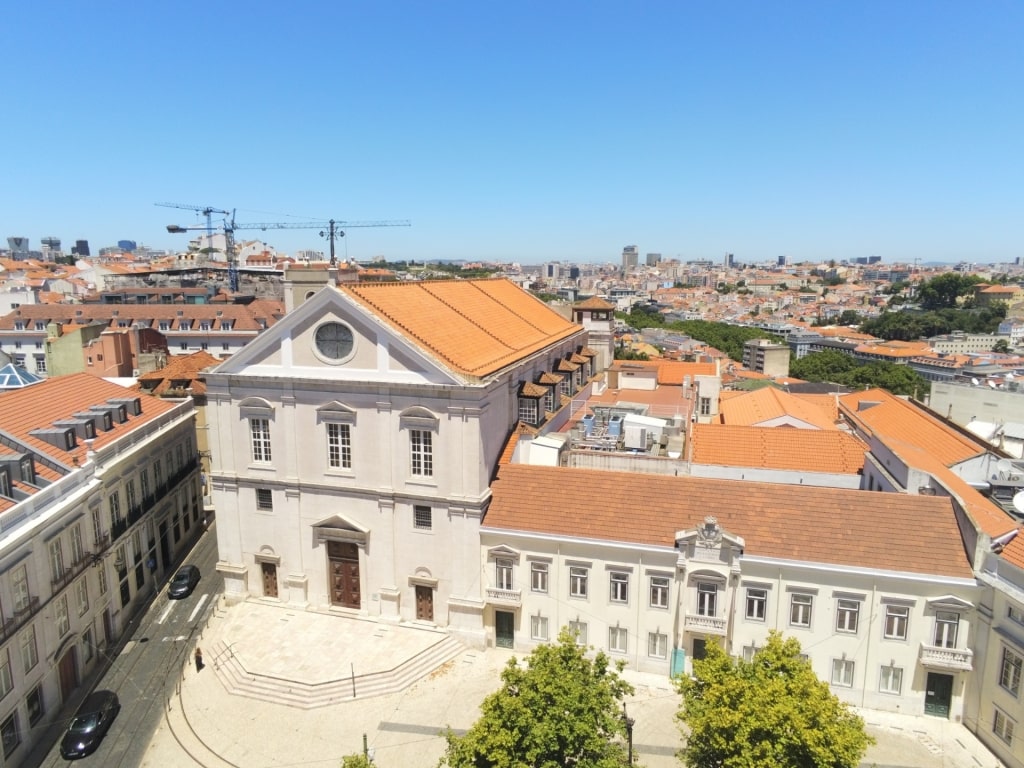
Igreja de São Roque
When the tragic earthquake of 1755 struck Lisbon, much of the city was reduced to rubble. Yet, a few of Príncipe Real’s religious buildings were spared from significant damage, leaving the district with some of the capital’s oldest original architecture.
The most impressive is the 17th-century Pomabline-style Convento dos Cardaes, which retains its historic glittering gilded altar, azulejos or Portuguese hand-painted ceramic tiles, and sacred art.
The 16th-century Igreja de São Roque, towards Bairro Alto, is also worth a visit. Don’t be fooled by the somewhat bland exterior; inside is an astonishing, wood-paneled, frescoed ceiling that soars above the multiple gilded side chapels.
Feel Lisbon’s Soul Via Fado
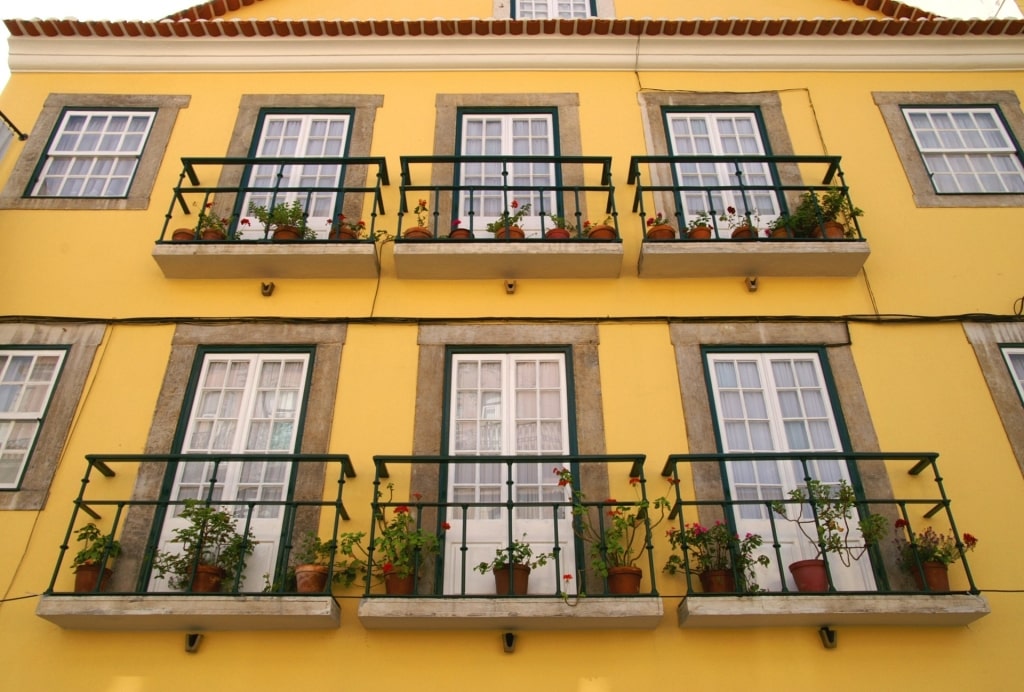
Amália Rodrigues House Museum
Fado, Lisbon’s melancholic musical genre of haunting vocals accompanied by guitar, is a must-experience when visiting the capital. In addition to the aforementioned underground performance, there are other memorable spaces to enjoy a performance in Príncipe Real, including the EmbaiXada shopping center, which hosts Real Fado concerts in its courtyard.
But to understand why fado is so intricately linked to the city’s working class and discover more about the genre’s most iconic performer, Amália, join a guided tour of the Amália Rodrigues House Museum, one of Lisbon’s best museums.
Still decorated as it was when the singer resided here in the 1950s, exhibitions focus on Amália’s life and achievements. On certain afternoons, low-key fado concerts are performed in the garden, usually affording a more traditional experience than some of the more tourist-focused fado houses.
Browse Galleries & Cultural Spaces
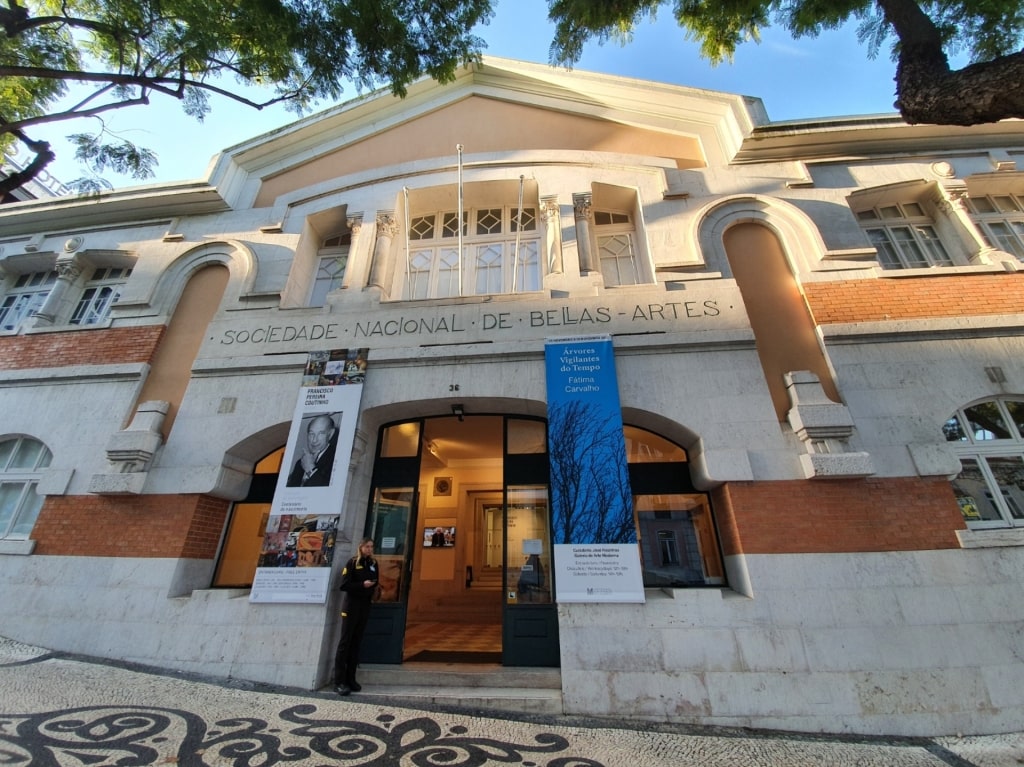
Sociedade Nacional de Belas Artes Photo by GualdimG on Wikimedia Commons, licensed under CC BY-SA 4.0
Alongside a handful of small art stores and galleries, Príncipe Real, Lisbon, hosts some of the city’s more intimate art spaces.
The Sociedade Nacional de Belas Artes, or SNBA, is usually delightfully quiet, allowing for peaceful reflection while admiring the artwork of predominantly Portuguese painters strung across the two main halls.
More contemporary, the Casa do Comum Cultural Center, which straddles the district’s border, showcases modern art and musical performances across its three floors. The center also houses a bar, book shop, and gallery.
Restaurants
Gin Lovers Bar & Restaurant
Spread across the Moorish-style courtyard and rear garden of EmbaiXada shopping center, Gin Lovers delivers much more than the name suggests—all against the backdrop of Príncipe Real’s one-time most stately residence.
Following an almost mandatory gin aperitif—opt for INseparable or Lisboa for a locally distilled gin—order a few of the typically Iberian dishes.
Select from petiscos or sharing plates, such as croquettes or plump, garlic-bathed shrimps, for a light lunch, or order a more filling Portuguese-style steak, swimming in a gravy-like sauce, or freshly grilled whole fish for a feast.
Padaria São Roque
For a quick snack with a side of legacy, pop into Padaria São Roque in Príncipe Real. This historical café is protected by the Lojas com Historia program.
Stepping through the deceptively simple exterior, you’ll be transported back a century. Towering marble columns soar towards the temple-like domed ceiling while the central slab of marble, embellished with azulejos and Art Nouveau flourishes, is usually piled high with various freshly baked breads.

Pastel de nata
It’s a time capsule of a place, harking back to the Lisbon of old. Order a crisp, warm pastel de nata for a mid-morning snack or one of the specialty breads. The staff are always happy to tell you the regional differences between those they bake. A version stuffed with cheese makes for a satisfyingly filling lunch.
Russo’s
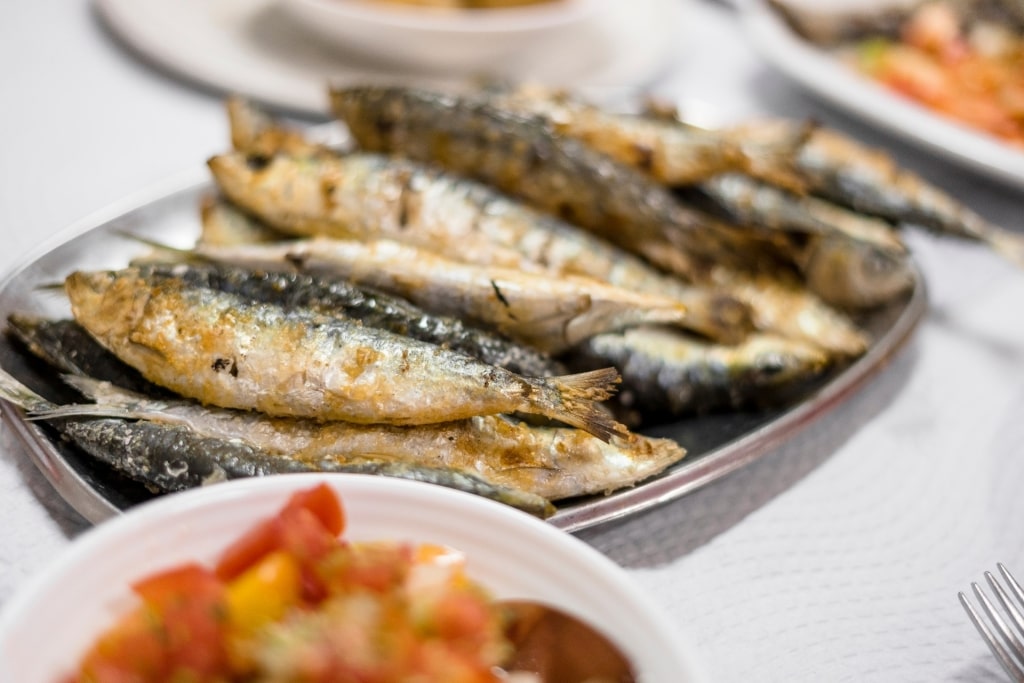
Grilled sardines
Small, intimate, and unfussy, Russo’s is a pocket-sized and perfect representation of a traditional Portuguese tasca. Seasonal specials, such as grilled sardines in summer or the market’s fish of the day are chalked up on the board, while the main card features a short but well-rounded selection of local and international dishes.
Portions are filling and small carafes of wine flow freely, adding a buzz to the typically paper-tableclothed dining room decorated with quirky canvases and vintage prints. The polvo, or octopus, a popular Portuguese food, is always an excellent pick.
Boubou’s
Tucked down a side street, chic and culinary-creative Boubou’s is one of the best restaurants in Príncipe Real, Lisbon. A whitewashed, marble-table dining room decorated with trailing plants leads to a snug garden, providing a delightful retreat on a warm evening. The vibe and aesthetic is very much contemporary Mediterranean.
Snag a table near the open-plan kitchen and you’ll witness excellence in action as the winner of the French TV show “Top Chef” 2022, Chef Louise Bourrat, helms the kitchen. The ever-evolving nine-course tasting menus are designed to help you discover Portugal, albeit with an international twist, through gastronomy, with courses separated by garden, land, and sea.
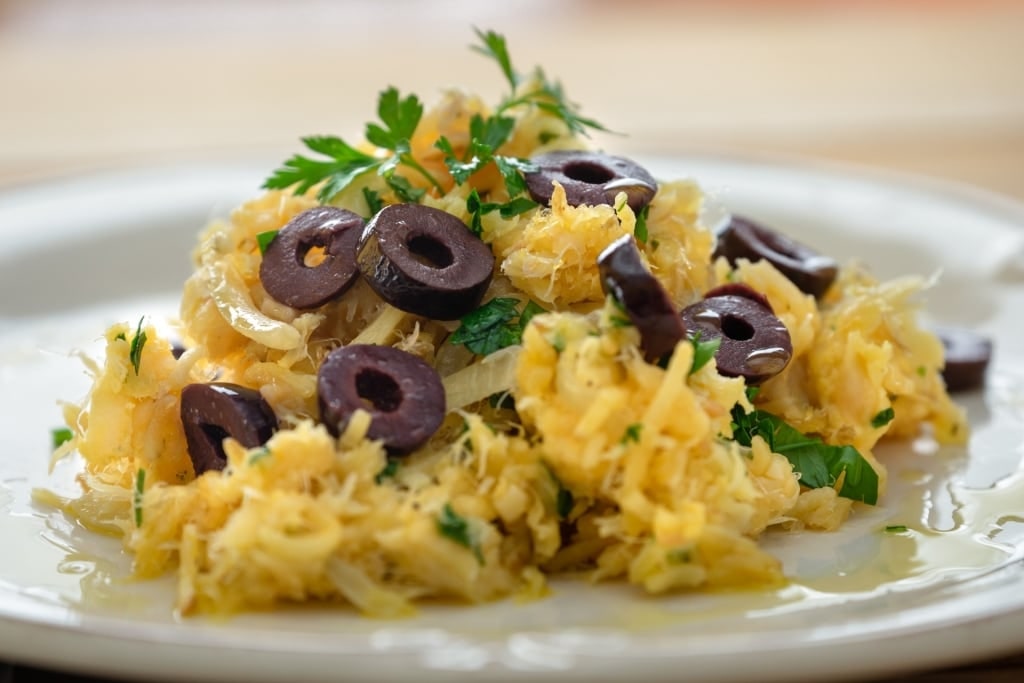
Bacalhau
The standout dishes often make the most of national ingredients. Sweet potatoes from the Algarve, Iberian black pork from the Alentejo’s hinterlands, and Portugal’s beloved—but imported—bacalhau, or salted cod, regularly appear. Pair it all with a bottle of the Douro’s finest from the extensive wine cellar.
Read: What to Eat in Lisbon
Cafeh Tehran
With a handful of tables spilling out onto leafy Praça das Flores—one of Príncipe Real’s pretty squares carpeted with calçada portuguesa, or patterned pavements—Cafeh Tehran serves a change of setting and flavors. Don’t arrive expecting a large dining room or menu—the focus is quality over quantity.
Spotlighting some of Iran’s tasties dishes, the menu is a fragrant feast. Expect an explosion of aromatic herbs and Asian spices as you work your way through dishes spanning lip-smacking soups, marinated meats, and freshly baked focaccia, all somehow made slightly more delicious by the terrace’s setting.
Travel Tips
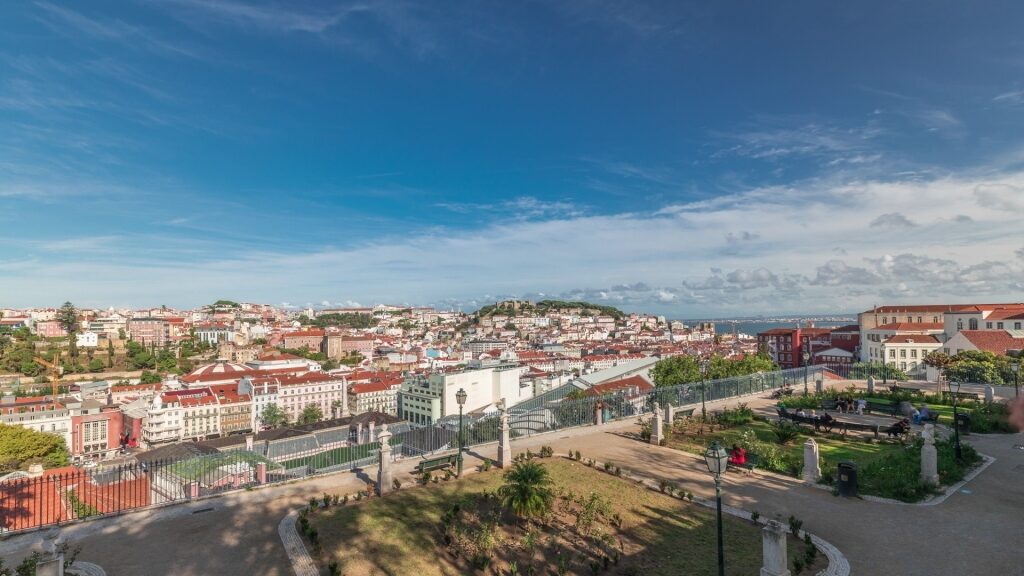
Miradouro de São Pedro de Alcântara
Príncipe Real is best explored on foot. The relatively compact district has many narrow streets that are not served by public transport, though the nearest metro stations, Avenida and Rato, aren’t far. From Baixa, the downtown area, two funiculars—Elevador da Glória and Elevador da Bica—trundle up towards Príncipe Real.
As with much of Portugal, it is helpful to carry a few notes in the local currency, Euros. International cards are accepted in most restaurants and stores, but some smaller cafés and kiosks only accept cash. Reservations are advised for most restaurants, especially the more intimate side-street dining rooms.
For much of the year, Lisbon enjoys a warm and sunny climate, and Príncipe Real’s excellent array of restaurants and independent boutiques make it one of Lisbon’s best neighborhoods to visit year-round. Be sure to slather sunscreen in the summer—even the gardens don’t provide enough shade to escape the sun.
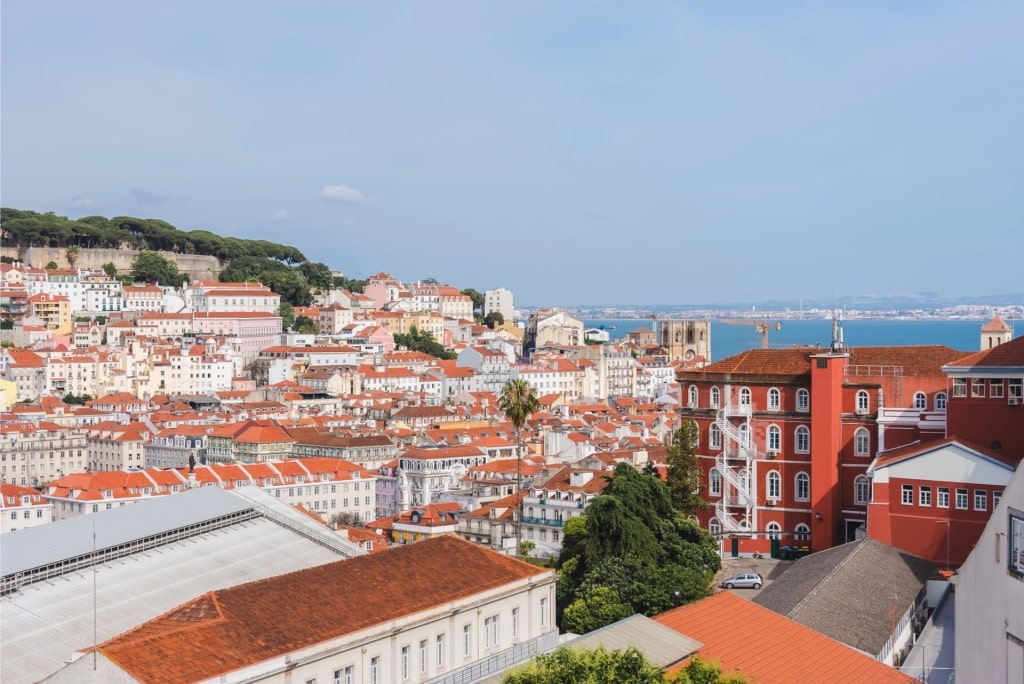
Lisbon
Ready to shop, dine, and explore one of the chicest neighborhoods in Portugal’s capital? Browse Celebrity’s cruises to Lisbon to plan your perfect vacation.
